What is Business Process Reengineering (BPR)?
Business Process Reengineering (BPR) is a management approach for fundamentally redesigning business processes with the aim of achieving significant performance improvements in areas such as cost, quality, service and speed .
In contrast to traditional process optimization, BPR does not focus on small improvements, but on a radical restart ("zero-based thinking") of processes. The focus is on the customer and their needs, supported by modern technologies
Why BPR? - The advantages at a glance
- Increased efficiency durch den Wegfall überflüssiger Prozessschritte
- Cost reduction through automated, standardized processes
- Better customer focus through lean, fast processes
- Digitization boost through targeted use of technology
- Faster market access thanks to shorter lead times
Who is Business Process Reengineering suitable for?
BPR is particularly relevant for:

BPR & digitalization: a powerful combination
BPR is not only a methodical lever, but also a digital one. Modern tools and technologies make it possible to implement new processes in a directly automated and scalable way
Process automation(RPA) - eliminate repetitive tasks
Low-code / no-code tools - flexible mapping of processes
Process mining - analyzing the current status in real time
BPM systems - centrally controlling and documenting processes
BPR project process: How business process reengineering works

Risks & challenges of business process reengineering
Although BPR offers many advantages, there are also critical success factors:
- Employee resistance to far-reaching changes
- Inadequate change management
- Focus on technology without cultural change
- Overly ambitious targets without an implementation plan
Recommendation: Gradual implementation with clear quick wins instead of a "big bang".
Conclusion: Is BPR worth it?
Business process reengineering is the right way to go if companies not only want to optimize, but also transform. Those who are prepared to rethink processes, integrate technology and involve employees will be rewarded with measurable efficiency and competitive advantages.
